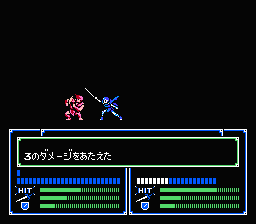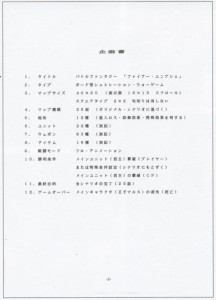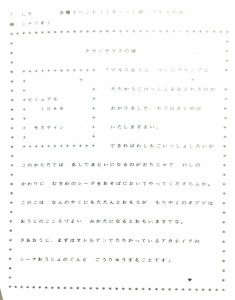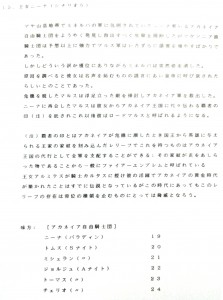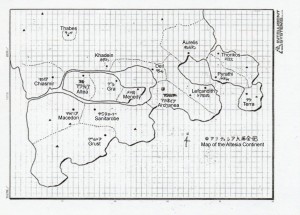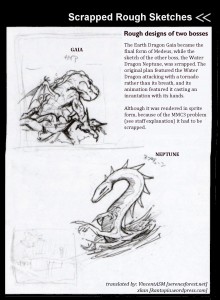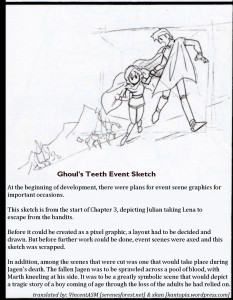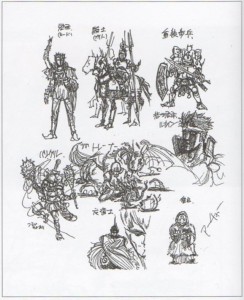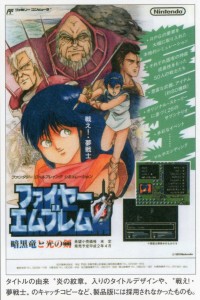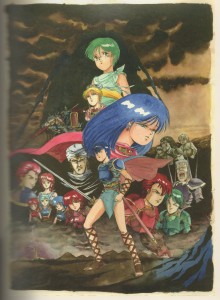The Making of Fire Emblem released in December, while far from perfect, was a treat for hardcore Fire Emblem fans, featuring many previously unknown development materials and secrets.
Of note, the 351-page book finally solved the mystery of Fire Emblem 64 and even revealed a never-seen-before Fire Emblem prototype for the Wii.
However that’s just the tip of the iceberg; in the coming weeks, I’ll be providing an in-depth look at many other exciting sections from the book in collaboration with Kirokan from Kantopia.
To get things rolling, it makes the most sense to begin with the game that started it all: the Famicom/NES version of Shadow Dragon (and the Blade of Light).
Note: A version of this article with commentary from Kirokan is available here.
Over the course of 25 long years, Intelligent Systems underwent many changes, so not all of the original Fire Emblem development materials are still available.
Therefore it’s rather fortunate for us that the staff apparently kept a healthy amount of documents from the days of the first Fire Emblem.
Above is the first (or second) page of the proposal document for the game. This is likely the document that Intelligent Systems sent to Nintendo to receive the green light for game development.
| 1. Title | Battle Fantasy “Fire Emblem” |
| 2. Type | Map-based strategy war game |
| 3. Map size | 40 x 30 (16 x 15 visible; able to scroll) Square type 2 x 2 no separation |
| 4. Map types | 26 (based on original story) |
| 5. Terrain | 12 (includes movement cost, defensive and special effects) |
| 6. Classes | 22 (listed separately) |
| 7. Weapons | 63 (listed separately) |
| I8. Items | 16 (listed separately) |
| 9. Battle scene | Full animation |
| 10. Victory conditions | Main unit (Lord) is defeated (Player) Or special condition (depends on the mission) Main unit (Lord) is defeated (Computer) |
| 11. Final objective | Complete all missions (25) |
| 12. Game Over | Main character (Marth) is removed from the map (killed) |
Most of the details are the same as the finished product, but there is one anomaly I noticed: in the final game, there are 55 weapons and 24 items, so it seems 8 weapons were replaced with items.
Next is a sample of a dialogue box in glorious ASCII form.
Most fans probably haven’t played the original NES Shadow Dragon to recognise the text, but those who played the DS remake should be familiar with it.
Prince Marth, I see you have finally decided to do battle with Grust; I will no longer hold you back.
Although I would love to join you, my body sadly isn’t what it used to be, so please keep my daughter Caeda by your side.
While my child won’t be much help, I’m sure her bodyguard Ogma will become your confidant and a powerful ally.
Well, Prince, you should first head to Aurelis where the army led by Archanea’s Princess Nyna are fighting and add to their forces.
This is of course the end-of-chapter dialogue from Chapter 1: Marth Embarks, but with many subtle differences.
Firstly, the location of the scene is Talys Castle like in the finished version, but the country is “Terra”, not Talys. Secondly, the king making this speech is explicitly labelled “Mostyn”, rather than “King Talys”.
Studious fans of Marth’s saga may recognise Mostyn as the name given to King Talys in the designer’s notes for Mystery of the Emblem; it’s interesting that he was known as Mostyn even this far back.
In addition, the primary antagonist is implied to be Grust, rather than Dolhr. Or maybe Dolhr’s role in the war isn’t clear at the very start.
Afterwards is a description of the early Chapter 5, dubbed “Princess Nyna”.
As Marth’s army finally launched an offensive to rescue the newly-located Archanean Free Company led by Nyna, who where surrounded by Minerva’s forces at the Maya Mountain Region, the Macedonian Iron Knights proved to be far more formidable than expected and the battle would only lead to unnecessary losses.
However for some reason, Minerva suddenly disappeared, despite having the upper hand.
After an investigation into the cause, it seemed she was recalled to meet the emperor because of slander from those who envied her fame.
Having avoided danger, Marth swept up the flustered enemies and rescued the Archanean soldiers.
Upon reuniting with Marth, Nyna entrusted him with the Conqueror’s Proof (Note), passed down by the Archanean royal family for generations; henceforth he became known as Lord Marth.(Note) The Conqueror’s Proof is a relief with the carving of the royal family’s emblem that the ruler bestows upon a hero should Archanea face a crisis; the carrier possesses the right to lead the entire army on behalf of the Kingdom of Archanea.
Commonly referred to as the Fire Emblem because of the flames featuring on the emblem, there is a legend that the knight Cartas received the emblem from Princess Artemis and from his success Archanea ushered in a golden age; even in this era, the existence of the relief poses a threat to those plotting to seize the imperial throne.Allies (Archanean Free Company)
Nyna (Paladin) -19
Dolph (Cavalier) -20
Macellan (Cavalier) -21
Jeorge (Knight) -22
Tomas (Knight) -23
Celio (Knight) -24
For the most part, the description is very similar to Champions of Aurelis, with a bit of Lefcandith Gauntlet mixed in. What’s radically different, however, are the allies recruited in this chapter.
Most importantly, Nyna was originally a playable character and a Paladin no less! However, in the end, her role was replaced with Hardin and she was relegated to a damsel in distress instead.
Perhaps Nyna the Paladin was the inspiration of Matilda the female blonde-haired Paladin in Gaiden?
As a side note, the “Archanean Free Company” is the name of the squad formed by Astram after the events of Shadow Dragon. So it’s nice that it eventually made it into the game.
More changes can be witnessed in an early draft of the game’s world map.
While the shape of the Altesia Continent is different to the Archanea Continent, the general shape and locations of the countries are vaguely similar.
The main difference is that many minor locations in Archanea appear to be their own countries in Altesia; perhaps this was changed to make the politics less complicated.
Observant fans may have noticed three locations not in the final game: Terra (which likely became Talys), Thorikos (Galder?) and something that looks like Sanitarobe (Dolhr?).
Additionally, above Archanea, you can make out a scribbled out “Altea”, while Altea also has something scribbled out above. Since Altesea is basically Altea with an extra letter, maybe Altea was meant to have a bigger influence on the world?
Moving on, we have sketches of two dragon bosses from the game.
As the picture explains, the “Earth Dragon Gaia” design was used for Medeus, the final boss, while the “Water Dragon Neptune” design was scrapped because of memory constraints.
However there’s a little more to it than that. Hidden within the game code of the NES version are a handful of unused dragon stones, including Wyvern, Gargoyle, Salamander, Shenron, Neptune and Dark Dragon.
Is it possible there were a lot more dragon types besides Water Dragon (Neptune) that were cut?
In addition, there are the following unused character names: Basilisk, Salamander, Naga and Gaia.
In the original NES version, Basilisk, Salamander and Naga are the names of the Demon, Fire and Divine Dragon tribes respectively. Logically Gaia may have been the name of the Earth Dragon tribe.
It wasn’t just dragons that had to be scrapped, a rough sketch of a cutscene image from Chapter 3 reveals that cutscene images were also cut to save memory.
It wasn’t until almost 13 years later, with the release of Blazing Sword, that cutscene images during missions would become a series standard.
Although ironically, the Chapter 3 cutscene in the DS version of Shadow Dragon simply focuses on the Ghoul’s Teeth, rather than Julian and Lena.
In any case, the remark about the scrapped cutscene featuring Jagen’s death is also very intriguing. The way it’s worded suggests Jagen was meant to die during the story.
In the end, we know Jagen lived to tell his tale, possibly because of gameplay reasons (removing your guardian unit would be inconvenient to the player) and/or because the cutscene was deemed too harrowing.
By the way, here’s the explanation for the aforementioned memory constraints:
There were plans for Shadow Dragon to use extravagant graphics in order to compete with other strategy games, which were very popular on the PC.
At the time, considering the maximum capacity of a Famicom (NES) cartridge was 2 Mbit, to produce battle scenes during phases, all the events that had been designed, left and right-facing sprites during battle scenes, it was necessary to use a special type of MMC3 cartridge.
However, during development we learned the maximum capacity of a MMC3 cartridge was 1 Mbit; from there, we started heavily compacting everything to accommodate the halved capacity. As a result, we cut down the 2 boss dragons we originally planned to 1 and got rid of the event scene graphics.
While my knowledge of NES hardware is rather limited, it’s no secret that games back then had much more limited memory to work with.
For the last bunch of sketches, we have some rough designs of classes.
Sadly, it’s extremely hard to identify the classes due to the low resolution of the image and because of the handwriting.
On the top row, going left to right, are Lord, Cavalier and Knight. On the bottom row are Mage and Priest. As for the middle row… well, your guess is probably better than mine!
Finally, here are two old adverts for the game. The left-most picture was used as a flier early on, before being replaced with a more polished version. (Some fans have probably seen it before)
Of note, “Fire Emblem” is spelt slightly differently to how it is now (Faiya Emuburemu versus Faiaa Emuburemu). In fact, this spelling is a common way to spell “Fire Emblem” and people in Japan sometimes incorrectly use it when referring to the series.
Meanwhile the right-most picture appeared on a pamphlet at a Japanese event where Fire Emblem made its first public showing. Prior to this, very few people had seen it; we have Yuka Tsujiyoko to thank for showing us this feast for the eyes.
